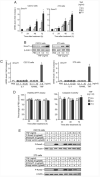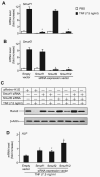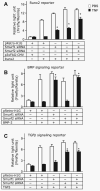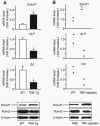Tumor necrosis factor promotes Runx2 degradation through up-regulation of Smurf1 and Smurf2 in osteoblasts
- PMID: 16373342
- PMCID: PMC2647592
- DOI: 10.1074/jbc.M509430200
Tumor necrosis factor promotes Runx2 degradation through up-regulation of Smurf1 and Smurf2 in osteoblasts
Abstract
Tumor necrosis factor (TNF) plays an important role in the pathogenesis of inflammatory bone loss through stimulation of osteoclastic bone resorption and inhibition of osteoblastic bone formation. Compared with the well established role of TNF in osteoclastogenesis, mechanisms by which TNF inhibits osteoblast function have not been fully determined. Runx2 is an osteoblast-specific transcription factor whose steady-state protein levels are regulated by proteasomal degradation, mediated by the E3 ubiquitin ligases, Smurf1 and Smurf2. We hypothesized that TNF inhibits osteoblast function through Smurf-mediated Runx2 degradation. We treated C2C12 and 2T3 osteoblast precursor cell lines and primary osteoblasts with TNF and found that TNF, but not interleukin-1, significantly increased Smurf1 and Smurf2 expression. TNF increased the degradation of endogenous or transfected Runx2 protein, which was blocked by treating cells with a proteasomal inhibitor or by infecting cells with small interfering (si)RNA against Smurf1 or Smurf2. TNF inhibited the expression of bone morphogenetic protein and transforming growth factor-beta signaling reporter constructs, and the inhibition of each was blocked by Smurf1 siRNA and Smurf2 siRNA, respectively. Overexpression of Smurf1 and/or Smurf2 siRNAs prevented the inhibitory effect of TNF on Runx2 reporter. Consistent with these in vitro findings, bones from TNF transgenic mice or TNF-injected wild type mice had increased Smurf1 and decreased Runx2 protein levels. We propose that one of the mechanisms by which TNF inhibits bone formation in inflammatory bone disorders is by promoting Runx2 proteasomal degradation through up-regulation of Smurf1 and Smurf2 expression.
Figures






Similar articles
-
Ubiquitin ligase Smurf1 mediates tumor necrosis factor-induced systemic bone loss by promoting proteasomal degradation of bone morphogenetic signaling proteins.J Biol Chem. 2008 Aug 22;283(34):23084-92. doi: 10.1074/jbc.M709848200. Epub 2008 Jun 19. J Biol Chem. 2008. PMID: 18567580 Free PMC article.
-
Tumor necrosis factor-α enhances the transcription of Smad ubiquitination regulatory factor 1 in an activating protein-1- and Runx2-dependent manner.J Cell Physiol. 2013 May;228(5):1076-86. doi: 10.1002/jcp.24256. J Cell Physiol. 2013. PMID: 23042144
-
Smurf1 inhibits osteoblast differentiation and bone formation in vitro and in vivo.J Biol Chem. 2004 Mar 26;279(13):12854-9. doi: 10.1074/jbc.M313294200. Epub 2003 Dec 29. J Biol Chem. 2004. PMID: 14701828 Free PMC article.
-
Regulatory mechanisms of osteoblast and osteoclast differentiation.Oral Dis. 2002 May;8(3):147-59. doi: 10.1034/j.1601-0825.2002.01829.x. Oral Dis. 2002. PMID: 12108759 Review.
-
Regulatory Roles of E3 Ubiquitin Ligases and Deubiquitinases in Bone.Biomolecules. 2025 May 7;15(5):679. doi: 10.3390/biom15050679. Biomolecules. 2025. PMID: 40427572 Free PMC article. Review.
Cited by
-
NEDD4 E3 Ligases: Functions and Mechanisms in Bone and Tooth.Int J Mol Sci. 2022 Sep 1;23(17):9937. doi: 10.3390/ijms23179937. Int J Mol Sci. 2022. PMID: 36077334 Free PMC article. Review.
-
NOTCH inhibits osteoblast formation in inflammatory arthritis via noncanonical NF-κB.J Clin Invest. 2014 Jul;124(7):3200-14. doi: 10.1172/JCI68901. Epub 2014 Jun 2. J Clin Invest. 2014. PMID: 24892805 Free PMC article.
-
Targeting Notch-Activated M1 Macrophages Attenuates Joint Tissue Damage in a Mouse Model of Inflammatory Arthritis.J Bone Miner Res. 2017 Jul;32(7):1469-1480. doi: 10.1002/jbmr.3117. Epub 2017 Apr 10. J Bone Miner Res. 2017. PMID: 28256007 Free PMC article.
-
Comprehensive analysis of epigenetics mechanisms in osteoporosis.Front Genet. 2023 Mar 28;14:1153585. doi: 10.3389/fgene.2023.1153585. eCollection 2023. Front Genet. 2023. PMID: 37056287 Free PMC article. Review.
-
CCL2, CCL5, and IGF-1 participate in the immunomodulation of osteogenesis during M1/M2 transition in vitro.J Biomed Mater Res A. 2017 Nov;105(11):3069-3076. doi: 10.1002/jbm.a.36166. Epub 2017 Aug 21. J Biomed Mater Res A. 2017. PMID: 28782174 Free PMC article.
References
Publication types
MeSH terms
Substances
Grants and funding
LinkOut - more resources
Full Text Sources
Other Literature Sources
Molecular Biology Databases

